India’s March Towards Educational Excellence
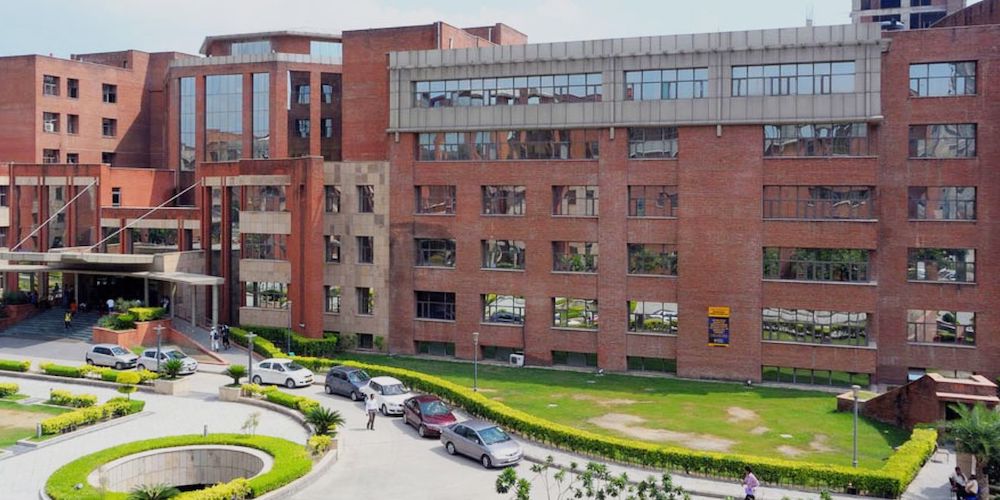
India is fast becoming a knowledge-based economy, thanks to strong institutional frameworks and visionary policy reforms. From reviving ancient centres of learning like Nalanda to pioneering cutting-edge initiatives, the country is not only preserving its academic heritage but also forging new paths in science, technology, and innovation. These institutions spread across education, defence, creative industries, space, and tribal development, are more than physical structures; they are enablers of progress, empowerment, and opportunity. As India builds the institutions of tomorrow, it is also laying the foundation for a self-reliant, future-ready Bharat
In its self-appraisal of achievements in the field of education during the last 11 years under Prime Minister Narendra Modi, the Government of India has highlighted the following points:
The National Education Policy 2020 introduced sweeping reforms to make education flexible, multidisciplinary and aligned with global standards and 21st-century needs.
• NIPUN Bharat Mission launched to ensure that every child attains foundational literacy and numeracy by the end of Grade 3 by 2026-27.
• More than 14500 PM SHRI (PM ScHools for Rising India) to be set up by strengthening the existing central / state / local body run schools.
• Higher Education Institutions: 70,018 in number (2025).Two foreign campuses of IITs have been set up in Zanzibar and Abu Dhabi.
• India’s rank in the Global Innovation Index improved from 76 in 2014 to 39 in 2024.
• In QS World Rankings, 54 Indian universities featured in the 2026 edition, up from 46 in 2025 and just 13 in 2015.
• The National Forensic Sciences University (NFSU) is the world’s only university dedicated solely to forensic science and allied fields.
It is of course a fact that over the past decade, India has undertaken transformative reforms under the National Education Policy (NEP) 2020 to strengthen both school and higher education. Groundbreaking initiatives like the NIPUN Bharat Mission, PM SHRI scheme, National Curriculum Framework, National Credit Framework promote flexibility, multidisciplinarity, and internationalization of education, thereby improving quality across thousands of institutions. New schemes such as PM Vidyalaxmi aim to reduce financial barriers to learning.
The expansion of Central Universities, IITs, IIMs, and AIIMS, along with the creation of pioneering institutions like Gati Shakti Vishwavidyalaya and the establishment of the Anusandhan National Research Foundation reflects a strong commitment to world-class education across disciplines. From foundational learning to advanced research in fields like quantum computing and creative technologies, these efforts are widening access, improving quality, and nurturing talent. India’s improved performance in global university rankings and the revival of heritage centres like Nalanda University further highlight its growing stature as a global hub for education, innovation, and opportunity.
Transformational Policy: NEP 2020
The National Education Policy 2020 proposes various transformative reforms in school as well as higher and vocational education. Built on the foundational pillars of Access, Equity, Quality, Affordability and Accountability, this policy aims to transform India into a vibrant knowledge society and global knowledge superpower by making both school and college education more holistic, flexible, multidisciplinary, suited to 21st century needs and aimed at bringing out the unique capabilities of each student.
Empowering India through World-Class Institutes
India is strengthening its knowledge economy by developing world-class institutions that foster innovation, global collaboration and high-quality education across diverse sectors. These institutions are key drivers of the nation’s aspiration to become a global leader in research, technology, and human capital.
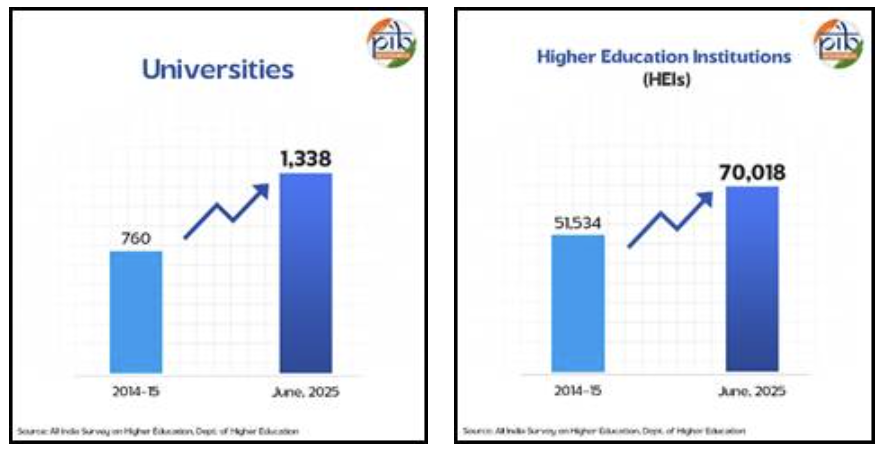
• Higher Education Institutions: According to AISHE portal, the number of Higher Education Institutions (HEIs) witnessed a remarkable 13.8% increase, rising from 51,534 in 2014-15 to an impressive 70,018 as of June 2025. This number contains Universities, Colleges, Standalone Universities/Colleges, PM Vidyalaxmi and Research and Development Institutes.
• University Growth: Universities grew from 760 in 2014-15 to 1,338 as of June 2025 showcasing India’s commitment to world-class institutions.
• College Growth: The number of colleges increased from 38,498 in 2014-15 to 52,081 as of June 2025, meeting the growing demand for higher education.
• IITs Growth: In 2014, there were 16 Indian Institutes of Technology (IITs). With the addition of 7 new IITs in the subsequent years, the total number has risen to 23 as of June 2025.
IIT Infrastructure Boost: On May 7, 2025, the cabinet approved Phase-B expansion for 5 IITs (Tirupati, Palakkad, Bhilai, Jammu, Dharwad). Additionally, ₹11,828.79 crore was sanctioned for infrastructure development from 2025 to 2029. On completion of construction, these five IITs shall be able to cater 13,687 students as against current student strength of 7,111 i.e. an increase of 6,576 students.

IIM: In 2014, there were 13 Indian Institutes of Management (IIMs). By June 2025, this number has grown to 21.
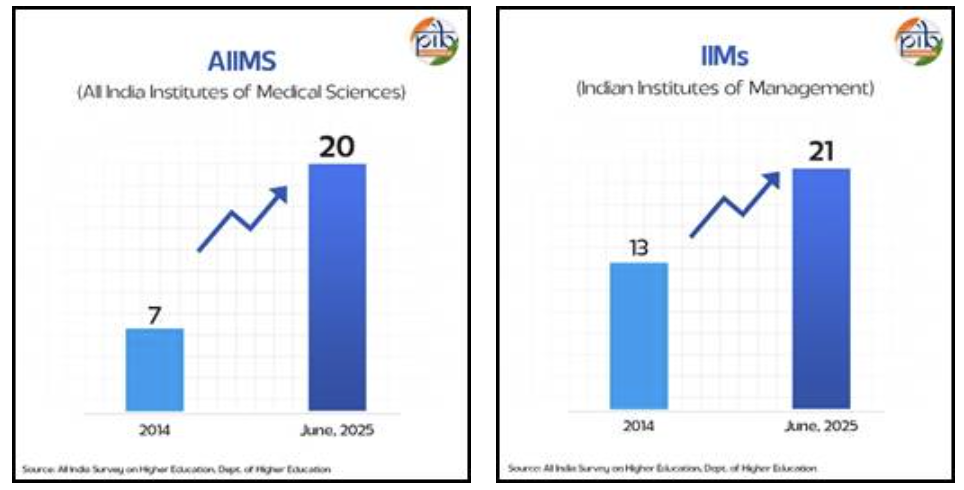
• Medical Education Boost: Since 2014, the number of AIIMS institutions has increased from 7 to 20 (June 2025), effectively tripling.
• School Upgradation: 14,500 schools to be upgraded under PM SHRI (PM Schools for Rising India) Yojana.
• The Eklavya Model Schools Initiative: The Eklavya Model Schools Initiative: EMRS aims to provide quality education to Scheduled Tribe (ST) in remote areas, ensuring equal academic opportunities. They are managed by the National Education Society for Tribal Students (NESTS) under the Ministry of Tribal Affairs. The number of functional Eklavya Model Residential Schools (EMRS) increased from 123 in 2013–14 to 477 in 2024–25.
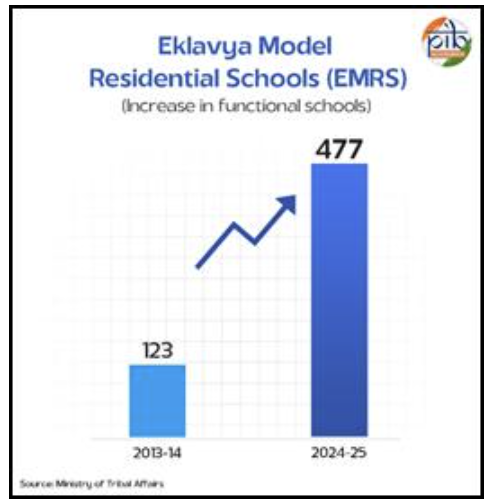
Improving Educational Infrastructure and Rankings
Flagship initiatives like the Higher Education Funding Agency (HEFA) and the World Class Institutions Scheme have enabled institutions to develop cutting-edge infrastructure and pursue academic excellence. The designation of Institutions of Eminence (IoEs), a growing presence in global rankings, and the expansion of premier institutes like IITs to international campuses in Zanzibar and Abu Dhabi reflect India’s ambition to position itself as a global hub for higher learning and innovation.
Forging Centres of Excellence for a New India
India has witnessed a transformative wave in institution-building, with the establishment of cutting-edge universities and centres of excellence across diverse fields, from transportation and forensic sciences to quantum technology and digital education. These institutions reflect the nation’s commitment to fostering innovation, industry collaboration, and global leadership in knowledge and skill development.
Gati Shakti Vishwavidyalaya
Gati Shakti Vishwavidyalaya (GSV), India’s first University in Transportation and Logistics sector, was established through the Central Universities (Amendment) Act 2022, passed by the Parliament in August 2022. Working under the Ministry of Railways (Govt. of India), the University was operationalised on 6th December 2022.
The university signed a Memorandum of Understanding (MoU) with Airbus in September, 2023. This MoU focuses on development of academic curriculum for aerospace and aviation sector, faculty support to conduct these courses, connecting with international academia, joint research and organizing joint events like symposiums, workshops etc. Further, the MoU promotes industry experience and training by Airbus experts for GSV students, institutional exchanges for faculty, students and administrative staff, scholarship for meritorious and needy students.
Indian Institute of Creative Technology (IICT)
Indian Institute of Creative Technology (IICT), a National Centre of Excellence being set up in Mumbai is poised to be a milestone in capacity building for Creative Economy. Dedicated exclusively to the AVGC-XR sector, the establishment of the Institute was formalized on Day-3 of WAVES 2025. WAVES also witnessed the signing of strategic MoUs with Industry Associations to transform IICT as a world-class institution in the M&E Sector. Some companies who have extended their hands for long-term collaborations are JioStar, Adobe, Google & YouTube, Meta, Wacom, Microsoft and NVIDIA.
National Forensic Sciences University
The National Forensic Sciences University (NFSU), erstwhile Gujarat Forensic Sciences University (GFSU) is the world’s first and only University dedicated to forensic science and its allied subjects. It has been set up under the Act of the Parliament in the year 2020 for providing quality and trained forensic manpower across all parts of the country. The headquarter of the NFSU is located in Gandhinagar, Gujarat and operates through various off-campuses and affiliated colleges which are set up based on factors such as availability of students, feasibility of location and willingness of the State / Union Territory Government etc.
Nalanda Reborn: India’s Journey to Reclaim Educational Excellence
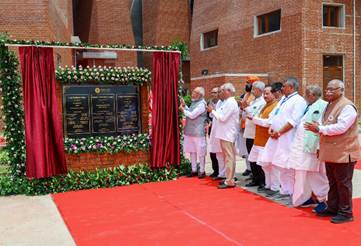
Located in the town of Rajgir in the northern state of Bihar, India, Nalanda University is a postgraduate, research-intensive international university established on 25th November 2010. It aimed to revive the renowned ancient seat of learning, which thrived from 5th century CE to 12th century CE, as the first residential university of the world.
In June 2024, a new campus of Nalanda University at Rajgir, Bihar was inaugurated. The University is conceived as a collaboration between India and East Asia Summit(EAS) countries.
The campus is a ‘Net Zero’ green campus. It is self-sustainable with a solar plant, domestic and drinking water treatment plant, water recycling plant for reusing wastewater, 100 acres of water bodies, and many other environment-friendly facilities.
The University has a deep connection with history. The original Nalanda University, established around 1600 years ago, is considered to be amongst the first residential universities in the world.
Anusandhan National Research Foundation (ANRF)
The ANRF aims to seed, grow and promote research and development (R&D) and foster a culture of research and innovation throughout India’s universities, colleges, research institutions, and R&D laboratories. It acts as an apex body to provide high-level strategic direction of scientific research in the country as per recommendations of the National Education Policy (NEP). It will forge collaborations among the industry, academia, and government departments and research institutions, and create an interface mechanism for participation and contribution of industries and State governments in addition to the scientific and line ministries.
New Government Initiatives
1. PM SHRI: Launched in September 2022, the PM SHRI (PM Schools for Rising India) scheme is a Centrally Sponsored initiative with a total outlay of ₹27,360 crore (₹18,128 crore as central share) for five years (2022–23 to 2026–27). The scheme aims to transform selected schools into model institutions showcasing all components of the National Education Policy 2020. These schools focus on quality education, holistic development and 21st-century skills, while also serving as mentor institutions for neighboring schools.
2. PM Vidyalaxmi: One of the major objectives of the Government is to ensure that no student is denied the opportunity to pursue higher education due to financial constraints. To support youth excluded from existing schemes, the Union Budget 2024–25 announced financial assistance for higher education loans up to ₹10 lakh. In November 2024, the Cabinet approved the “Pradhan Mantri Vidyalaxmi” (PM-Vidyalaxmi) scheme to ensure that financial constraints do not hinder meritorious students from accessing quality education.
3. Central Sector Interest Subsidy Scheme (CSIS) and Credit Guarantee Fund Scheme for Education Loan (CGFSEL): Under this Scheme Interest Subsidy is given during the moratorium period i.e., Course period plus one year on Education Loan taken from the Scheduled Banks under the Model Education Loan Scheme of Indian Banks Association to students belonging to economically weaker sections whose annual parental income is up to Rs. 4.5 Lakh from all sources.
4. International Cooperation: India has signed Educational Exchange Programmes/MoUs with 51 countries and actively collaborates with international bodies like UNESCO, BRICS, SAARC, ASEAN, etc to promote academic cooperation, student exchange, and mutual recognition of qualifications. [11] The Ministry of Education runs the Study in India scheme to attract foreign students to come and study in Indian higher education institutions. The ministry also runs the Scheme for Promotion of Academic and Research Collaboration for joint research between Indian and foreign universities. In line with NEP 2020 recommendations, several international universities are setting up campuses in India, while IIT Madras has opened a branch in Zanzibar and IIT Delhi in Abu Dhabi.


